List of Authors
>>About this blog
Recent blog post
|
[Sumida Fireworks]
February 19, 2015 14:00
Akashi-cho, Chuo-ku, next to Tsukiji Temple.
There is St. Luke International Hospital in Akashicho, but in February, my family decided to be hospitalized at this hospital. This time, it is a good opportunity, but as a patient's point of view, I went around the hospital.
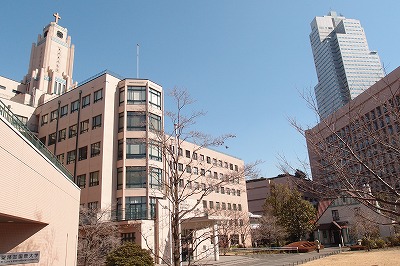 The building with the cross spire on the left side of the photo is the old building, the tower building on the right side is the St. Luke's Tower, and the building between these two buildings is the main building, and these three buildings are connected by corridor-like passages at the second floor level. Inpatients spend time in the main building in the middle. The building with the cross spire on the left side of the photo is the old building, the tower building on the right side is the St. Luke's Tower, and the building between these two buildings is the main building, and these three buildings are connected by corridor-like passages at the second floor level. Inpatients spend time in the main building in the middle.
The main building and St. Luke's Tower are relatively new buildings built in the 1990s, but the old building is based on buildings built in 1933 and is a historic building.
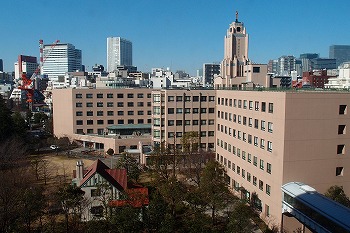
Also, at night, a spiral with a cross shines, making it a symbol of Akashicho.
When you come to the Akashicho area, it feels strange that it makes you feel somewhat positive, but I think that it is thanks to this building that makes such an atmosphere.
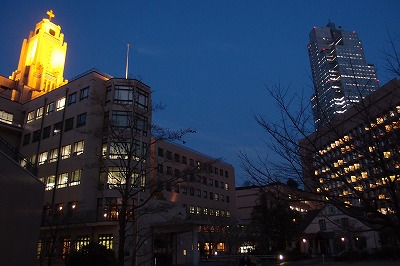
In this old building, there is an old chapel (chapel) built in 1936, but until now there was no chance to enter, so I just looked up at the chapel building from the north side of the old building.
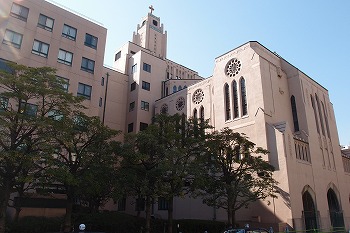 However, this time, I was blessed with the opportunity to visit several times before surgery, the day of surgery, and the rehabilitation walking after surgery. However, this time, I was blessed with the opportunity to visit several times before surgery, the day of surgery, and the rehabilitation walking after surgery.
From the main building to the old building, we used the corridor on the second floor. As you proceed along the corridor, you will see a gallery where you can see the Toysler Memorial Hall below, and further you will reach the space on the second floor, which is the center of the old building.
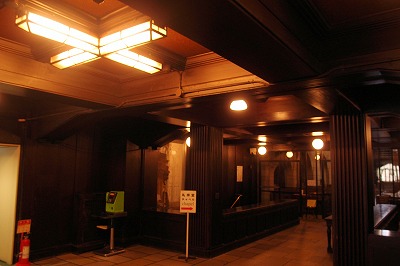 Right on the right is the chapel, but the entrance is glass-covered and you can see inside from outside the chapel. Perhaps because of that, I thought it was a chapel that was easy to enter. Right on the right is the chapel, but the entrance is glass-covered and you can see inside from outside the chapel. Perhaps because of that, I thought it was a chapel that was easy to enter.
In the past, when this old building was a ward, the patient was able to see and pray in this chapel from each floor above, and it was said that the hospital and chapel were integrated.
The inside of the chapel is a sacred space, so I couldn't take photos, but I was surprised at the high ceiling that I couldn't imagine from the exterior of the chapel.
When I sit in a chair, I look at the ceiling all the time.
The wall continues to the ceiling as if it were piled up of stones, and it is strange that it would not fall.
Gentle light shines through the tall window of the stained glass.
It is a calm space and healing space where the sound of pipe organ constantly flows in a majestic atmosphere.
When you leave the chapel, there is a chapel break space on the other side.
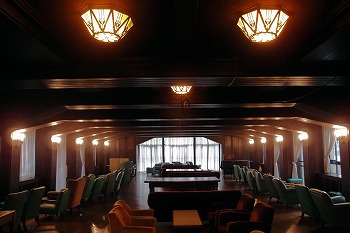 This place is also an old building, so the floor is Mississi-style. If you sit in a chair, you will be sleepy with a good feeling. This place is also an old building, so the floor is Mississi-style. If you sit in a chair, you will be sleepy with a good feeling.
This chapel is held not only for those who work, learn, and patients in the hospital, but also for those outside, and regular pipe organ concerts are held.
This time, I also visited the concert held on the first Wednesday evening of every month, and I was able to spend a good time immersed in a good atmosphere. That day was after the day of the surgery, so it may have been felt more because of a sense of security.
This time, I thought it would be good to come again, not as a patient's point of view.
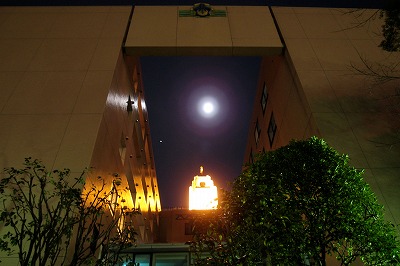
[Mapo ★]
February 19, 2015 09:00
When I went to the medical checkup, there was a special Ginza hanako.
It's the shop listed on it.
There was a wine tasting from night on this day.
I wanted to have lunch for a little more slowly.
I'm happy to have lunch until 17 o'clock (*^^*)
The site is located on the first basement floor of the UK Building in front of Matsuzakaya, which is currently under construction.
It was underground, but there was no feeling that it was difficult to enter at all, and there were many women.
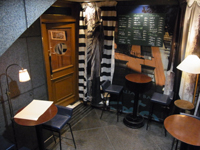 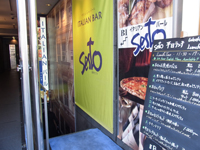
The entrance looks like this, going down the stairs.
And on this day, there was an elderly couple of Western descent next to me.
There seems to be an English menu too.
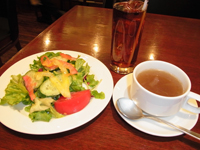 
Lunch is very reasonable.
A limited set of 10 meals (1000 yen) is a doria.
I wanted to eat rice, so I tried it.
There are a lot of lunch with stone kiln pizza and pasta.
If you go with a few people, you will enjoy sharing and eating various kinds.♪
Ginza Sest homepage
[Shitamachi Tom]
February 17, 2015 14:00
This month, the "Tokyo Marathon" may be held, and I often see runners who practice around Tokyo. This event has become quite well established. Even in Chuo-ku, Ginza, Nihonbashi, Tsukiji, etc. are included in the driving course, so many supporters and spectators come. At that time, I hope that you can enjoy sightseeing and shopping in Chuo-ku together.
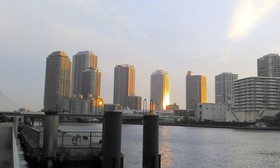
The running boom is still booming. I run myself occasionally, but there are many people who can't forget the exhilaration after running and gradually get stuck. Every fall, the “Chuo Kumin Marathon” is also held, so if you have been hesitant, why not start running little by little on this occasion? It's still cold now, but it's getting better as I'm running. In fact, winter is the best season for running.
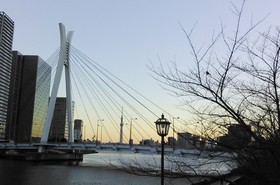
I think that each person who runs has their favorite running course. Chuo-ku is the most urbanized area, so there are no hills or vast parks like the suburbs. If anything, it may be fun to run like sewing an alley in the city.
In such a situation, my favorite is the Riverside of the Sumida River. In the ward, there is a promenade along the riverside from Eitai Bridge to Kachidokibashi, so I think it is the best course for walks and jogging. It is pleasant to run slowly while watching the waterside scenery.
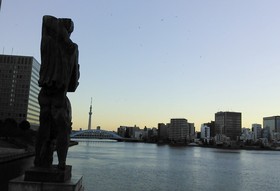
I recommend running early in the morning. You can run while relaxing in the tranquility of the moment before the town still starts moving. In the cold season, the air is clear, so you can see the sky clearly. During the time when the sky around Tsukuda becomes brighter, the scenery where the appearance of the high-rise apartment and the river live together is also impressive.

Let's meet at Riverside!
[Shiraji]
February 17, 2015 09:00
Once a month, Ginza "Ashino Salon" holds seminars for Kabuki fans such as tea theory (Saron), soil (Do), and Kabuki.
The content will be Kazuko Kanamori as a lecturer, and in order to enjoy Kabuki more deeply, the history and author of the performance centering on the performance of the Kabukiza Theater performance of the following month, the highlights of each curtain and the relationship between actors and roles, props and props The purpose is to give a lecture on the meaning of the scenes, etc., and to understand Kabuki more and immerse yourself in its charm.
This time, a resume was distributed to the large Kabuki "Sugawara Densetsu Handbook" in March, and a detailed explanation was given using videos.
Sometimes kabuki actors come to see you....。
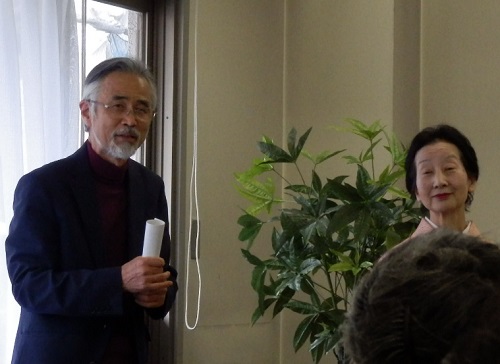
Mr. Takao Ashino, the organizer, and Mr. Kazuko Kanamori, the lecturer
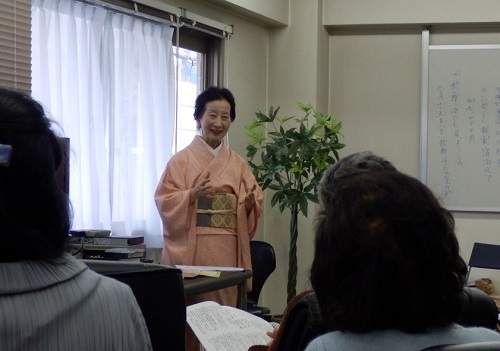
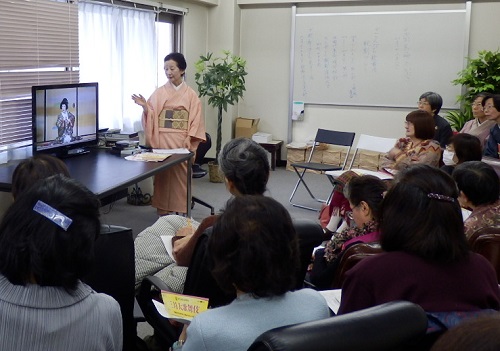
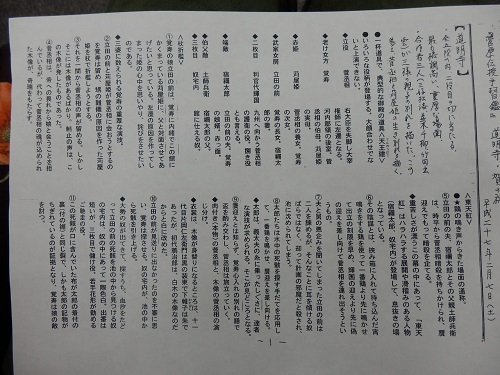
During the break on the way, Japanese plum sweets and matcha were distributed in connection with the performance "Sugawara Densetsu Handbook".
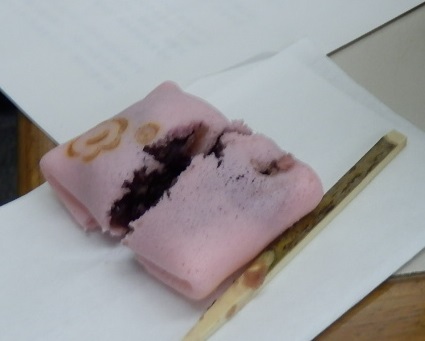

Seminar lecturer Kazuko Kanamori has been free since 1976 after editing "Quarterly Kabuki" published by the Shochiku Theater Department, and has been involved in writing, editing, and reprinting mainly Kabuki for its spread, and since 1978 I have written an outline of Kabuki performance programs in Kabukiza, Osaka, Kyoto, and Nagoya for a quarter century. He has authored many books such as Kabuki Fashion, Kabuki Highlights to Understand easily, Kabuki Encyclopedia,Yoshitsune Senbonzakura, and others.
For Kabuki fans participating in this seminar, tickets for both theaters of Kazuko Kanamori and Konpira Kabuki Theater Theater Theatre 4/13 (Mon) Part 2 and / 14 (Tue) Part 1 There is also a plan of 47,000 yen (limited to 25 people) for a night inn. (Local assembly and dissolution)
Tickets alone (14,000 yen x 2), so I think it would be advantageous to be able to have a two-part co-watch "Konpira Kabuki", which is difficult to obtain, can be played together with "Kazuko Kanamori" and listen to the story.
For those who can't go far, there is also a gathering called "Kabuki Watching Party", and the March performance is in the afternoon of March 15 (Monday).
In addition, the next "Tea theory (Saron), Soil (Do) and Kabuki" is 4/18 (Sat).
Membership fee ¥3,500 (with tea and sweets)
Capacity limited to 35 people (reservation required)
The organizer, Maigeisha, is an organization that aims to spread traditional performing arts (Japanese music, kabuki, folk performing arts, etc.) based on work related to the production of traditional performing arts and performing arts, as well as management work related to traditional performing arts, as well as workshops such as Gitayu and Narumono in variouslocal play.
By the way, Mr. Takao Ashino, a member of the All Japan folk performing arts Association, was once the nephew of Japan's leading male chanson singer Hiroshi Ashino.
For inquiries, please contact Maigeisha TEL & FAX 03-3260-5780 E-MAIL: [email protected]
Takao Ashino 090-1766-1114
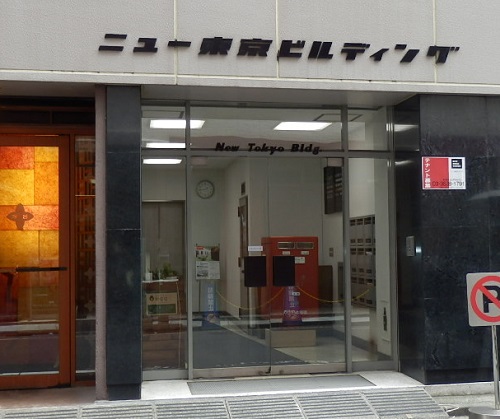
At the venue "New Tokyo Building", there is a post box in the entrance hall for some reason.
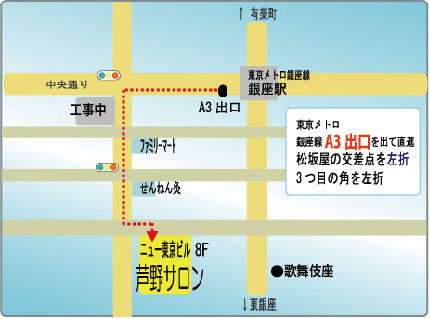
Ginza "Ashino Salon" 5-11-13 Ginza, Chuo-ku New Tokyo Building 8F Ashino Onsen Co., Ltd.
3-minute walk from the A3 exit of Ginza Station on the Hibiya Line.
3-minute walk from Exit A1 of Higashi-Ginza Station on the Hibiya Line and Toei Asakusa Line.
1.
February 15, 2015 09:00
"Muromachi Sandbox" is a well-known long-established store in Soba-dori in 1869, but this time we will introduce the sweet "Soba Zenzai". I didn't have a chance while thinking "once of the time."
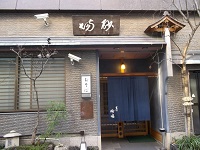
It was a pleasant guide after the peak of noon, saying, "That seat is warmer." My friend is two "Mori", and I am a seasonal "Ara soba" (market price). I'm a little bit surprised at the "market price", but I'm a little hungry, "Is it okay because it's not a sushi restaurant?" After flattening it, it's finally "Soba Zenzai". I was a little surprised to imagine that "soba is in the soup flour"! If you take a bite of hot dry bean paste and soba, unlike the appearance, it will be surprisingly compatible. "Yes, there are soba buns, and the combination of soba and bean paste is not particularly unusual," he said. This is also complete in no time. I'm going to be a little shy.
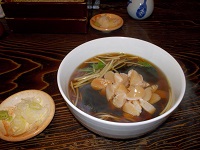 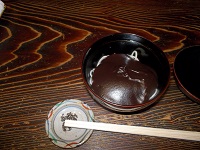
Try the suspicious direction, "Is it sweet at a soba shop?" Those who are worried about the "market value" of "Ara soba" are now.
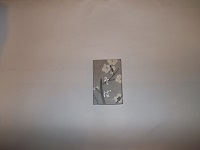
This is also a famous match in February.
I would like to introduce you again when you have accumulated a lot in the 12th month.
Muromachi Sandbox 4-1-13 Nihonbashi Muromachi TEL 03-3241-4038
11:30-21:00 (Saturday 16:00) Holiday holiday
[Dimini ☆ Cricket]
February 14, 2015 14:00
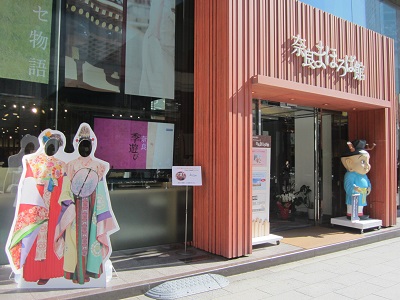
A lecture entitled "Manyoshu and Kanji" was held at Nara Mahorobakan, located opposite the Nihonbashi Mitsukoshi New Building, facing Chuo-dori, Nihonbashi Muromachi 1-chome.
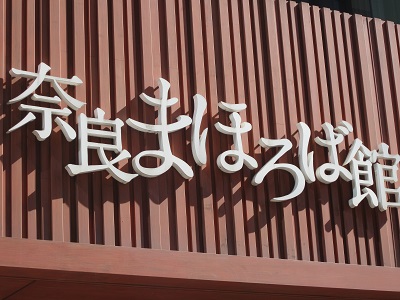
Lecturer is Shin Oyama, Associate Professor, Faculty of Letters, Nara Women's University.
The time was about an hour and a half, but the teacher's story was very interesting, and when there was no hiragana or katakana, how to express "Yamato Kotoba no Uta" using only foreign characters called "Kanji" It was a lecture that impressed me about the ingenuity and wisdom of our predecessors,  and our ancestors were really great. and our ancestors were really great.
This course is the first and the second and third sessions, with the theme of "Tradition of Buddhism," "Naoya Shiga," and "Minamoto no Yoshitsune," which are related to Nara.
I think it's a good course to get intellectual stimulation, so if you are interested, please apply by all means.
Anyone can participate on a first-come, first-served basis by applying from a postcard, fax, or Nara Mahorobakan website.
On the day, at the exhibition corner on the first floor, costumes from the Tenpyo era were displayed.
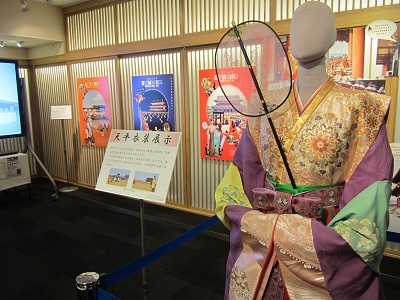
In addition, the photo below  shows the popular products of the hotel, "Kaki weather" (left) and "Dried persimmon jelly". "Kaki weather" is a dried fruit that slices the sweet persimmon Fuyu persimmon, and the more you chew, the more sweet it becomes. shows the popular products of the hotel, "Kaki weather" (left) and "Dried persimmon jelly". "Kaki weather" is a dried fruit that slices the sweet persimmon Fuyu persimmon, and the more you chew, the more sweet it becomes.  "Dried persimmon jelly" also has a condensed original taste of persimmons, both of "Dried persimmon jelly" also has a condensed original taste of persimmons, both of  which are healthy Nara Is a famous persimmon production area. which are healthy Nara Is a famous persimmon production area.
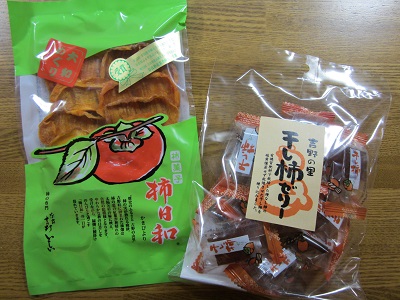
"Nara ni persimmon " came to mind immediately. When the bell rings, Horyuji Temple (Shiki) " came to mind immediately. When the bell rings, Horyuji Temple (Shiki)
Shiki wrote  such a phrase that seems to have liked big persimmons. such a phrase that seems to have liked big persimmons.
"(Before writing) After death," Kakikuhi's Yoshimi Haiku and Denfushi (Shiki)
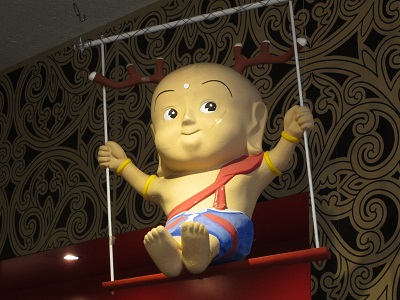
Click here for the Nara Mahoroba-kan website ⇒ http://www.mahoroba-kan.jp/index.html
  
Kana Yokomachi of Inuboe Yuru Nara after falling persimmons (Shiki)
|
Links
|
 The building with the cross spire on the left side of the photo is the old building, the tower building on the right side is the St. Luke's Tower, and the building between these two buildings is the main building, and these three buildings are connected by corridor-like passages at the second floor level. Inpatients spend time in the main building in the middle.
The building with the cross spire on the left side of the photo is the old building, the tower building on the right side is the St. Luke's Tower, and the building between these two buildings is the main building, and these three buildings are connected by corridor-like passages at the second floor level. Inpatients spend time in the main building in the middle.

 However, this time, I was blessed with the opportunity to visit several times before surgery, the day of surgery, and the rehabilitation walking after surgery.
However, this time, I was blessed with the opportunity to visit several times before surgery, the day of surgery, and the rehabilitation walking after surgery. Right on the right is the chapel, but the entrance is glass-covered and you can see inside from outside the chapel. Perhaps because of that, I thought it was a chapel that was easy to enter.
Right on the right is the chapel, but the entrance is glass-covered and you can see inside from outside the chapel. Perhaps because of that, I thought it was a chapel that was easy to enter. This place is also an old building, so the floor is Mississi-style. If you sit in a chair, you will be sleepy with a good feeling.
This place is also an old building, so the floor is Mississi-style. If you sit in a chair, you will be sleepy with a good feeling.










